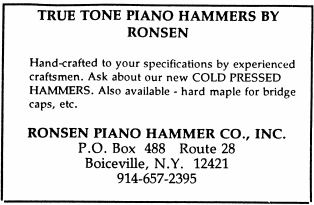
|
When an upper treble string breaks on a spinet piano, it is often difficult to disengage from the bridge pins and hitch pin because of the limited space for your hands behind the drop-action. I have found that the split grand screwdriver blade for the slotted round nuts on the key rails (APSCO #16249) in the combination handle permits easy access from above to hook and remove the broken string from the angled pins. The straight damper regulator for the combination handle (APSCO #16128) can also serve the same purpose.
|

by Paul Eccardt
At last months meeting Eric Schandl gave an excellent technical on several topics. One of the things that he demonstrated was a very impressive way to show that pianos sound better when they are tuned with lots of stretch in the treble section. He demonstrated it by playing a chord in the middle section, then playing single notes one, two, three, and four octaves higher. All the tuners/technicians that attended agreed to have Eric tune those notes higher and higher. When we were done, we checked them by playing the octaves together, and we found that the notes were way too sharp. We couldn't hear beats until we played them together.
I've learned over the years that many musicians prefer stretched octaves, and they aren't much bothered by beats. Another reason that the mathematically pure octave isn't so good is if your strings move ever so slightly with a hard blow, they will be moving down, making your octaves flat. Let's face it, who are we tuning for, other tuners or musicians?
